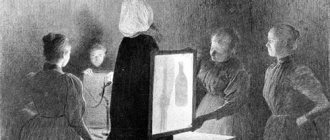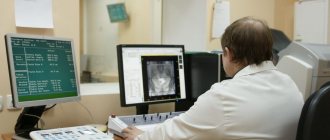Contrast agents in magnetic resonance imaging
The basis of any imaging method is the ability of the eye to distinguish image areas by their brightness. The contrast of the pathological focus in relation to the surrounding tissues depends on the intrinsic properties of the tissue and the method of obtaining images on tomograms. In magnetic resonance imaging (MRI), the image obtained on tomograms is based on the magnetic characteristics of tissues, the main of which are proton density (p) and relaxation times T1 and T2.
The magnetic characteristics of an object during MRI with contrast are influenced by the content of water, large molecules (mainly proteins), ions and free radicals. These ratios are almost always violated in pathological conditions . Thus, inflammation is accompanied by an increase in the amount of intracellular and extracellular water, and tumors - intracellular water. Water lengthens relaxation times, protein molecules, ions and radicals shorten them.
Hemorrhage behaves differently on tomograms. Deoxyhemoglobin is diamagnetic. Methemoglobin acts as a paramagnetic; in undestroyed red blood cells it shortens relaxation times. Once the red blood cells are destroyed , a superparamagnetic effect occurs and the blood appears bright on T1-weighted scans. Hemosiderin has high magnetic sensitivity, leading to rapid dephasing of surrounding protons, the blood appears dark on the tomogram.
Proton density - the number of resonating protons per unit volume - differs little between tissues under normal and pathological conditions. The exception is adipose tissue, which has the highest proton density and therefore high signal intensity, especially on T1-weighted tomograms. The low proton density of compact bone tissue makes it appear dark in any type of weighting image.
In most cases, the natural contrast of MR tomograms is sufficient to identify and characterize the pathological focus. At the same time, there are situations when the pathological focus is not visualized on the tomogram due to isointensity or small size. It can be difficult to determine the boundaries of pathological changes on MRI and evaluate the internal structure. In such situations, diagnostics with the introduction of contrast agents , the so-called, Contrast-enhanced MRI. In addition, there are other special uses of contrast agents. The point of application of magnetopharmaceuticals is relaxation times. Contrast agents for MR studies change them nonspecifically and directly. In this regard, they are fundamentally different from contrast agents used in radiology, which are themselves visible due to the high x-ray density, therefore, it is more correct to call them contrast agents.
Positive contrast agents belong to the group of paramagnetic agents. Paramagnets contain as an active part ions with unpaired electrons in the outer orbit - Gd3+, Mn2+, Fe3+, Cr3+, etc. Today, gadolinium salts (Gd3+) are of practical importance when performing MRI with contrast, since the remaining ions are more toxic and poorly soluble.
Gadolinium belongs to the rare earth elements from the lanthanide group. Gadolinium contains seven unpaired electrons, which preferentially shorten the spin-lattice relaxation time (T1). As a result, the pathological focus becomes bright when examining the tomogram. Gadolinium in the form of simple salts is very toxic, so it is included in chelates. The table shows the main gadolinium compounds produced as contrast agents for MRI diagnostics.
| Contrast agents containing gadolinium (Gd3+) | |||||
| Name MRKS | Chemical compound | Abbreviation | Chemical structure | Charge | Manufacturer |
| Omniscan | Gadodiamide | Gd-DTPA-BMA | Linear | Nonionic | Nycomed Austria |
| Magnevist | Gadopentetate dimeglumine | Gd-DTPA | Linear | Ionic | Schering Germany |
| Multihans | Gadobenate dimeglumine | Gd-BOPTA | Linear | Ionic | Braeco Italy |
| Primovist | Gadoxetic acid disodium salt | Gd-EOB-DPTA | Linear | Ionic | Bayer Schering AG (Germany) |
| Vazovist | Gadofosveset trisodium salt | Gd-DTPA | Linear | Ionic | Mellinckrodt Medical Ink USA |
| Prohans | Gadoteridol | Gd-HP-DO3A | Cyclic | Nonionic | Braeco Italy |
| Gadovist | Gadobutrol | Gd-BTDO3A | Cyclic | Nonionic | Schering AG (Germany) |
| Dotarem | Gadoterate meglumine | GdDOTA | Cyclic | Ionic | Guerbet France |
The principle of action of contrast agents in MRI diagnostics is the same, although with some pharmacological and pharmacokinetic differences.
When administered intravenously, contrast agents enter the intercellular space of tissues without remaining in the vascular bed. Accumulation in pathological tissues (except the central nervous system) depends on the vascularization of these formations. Gadolinium preparations in combination with medium polymer chains are retained in the vascular bed for a relatively long time and can be used for contrast MR angiography and contrast-enhanced brain tomography.
Gadolinium-based contrast agents should be used with caution in patients with kidney disease.
In the form of fat emulsions, gadolinium is potentially useful as a gastrointestinal contrast .
Negative contrast agents contain Fe2+ or Fe3+ as the active part. In its action, iron acts as a superparamagnetic. Endorem is used to detect focal liver disease (liver MRI). Lumirem, Gastromark, Abdoscan are used for contrasting the gastrointestinal tract. Our department uses only contrast agents containing gadolinium.
Carrying out an MR study with a contrast agent consists of two stages. First, an MRI scan of the relevant department is carried out with standard requirements. The need for contrast enhancement is determined based on the data of this particular study. If the patient agrees and there are no contraindications, the doctor determines the dosage of the contrast agent and the method of its administration. Before the re-examination, the patient is taken out of the tomograph tunnel. A catheter is installed in the vein of the elbow, through which a contrast agent is injected. Intravenous administration can be carried out manually or using an electronic injector.
For automatic injection of contrast agent, we use a two-head injector Opti s tar LE. It is specially designed for magnetic resonance imaging, and operates in magnetic fields up to 3.0 Tesla.
The working head and vertical stand with base, located next to the magnetic resonance imaging scanner, are made of non-magnetic materials.
The injector allows for various contrast agent injection schemes. Front loading of two disposable syringes is used, filled with a contrast agent and saline solution, respectively.
OptiStar LE injector provides injection with changing programmable parameters: injection rate, pressure, volume of contrast agent, injection delay, drip mode of saline solution.
The patient is prohibited from changing body position and moving during the entire examination.
If a study with the introduction of a contrast agent is planned, it is necessary to ensure the accessibility and patency of the superficial veins. If venous puncture is difficult (a course of chemotherapy was carried out, anatomical features, etc.), care must be taken to install a venous catheter before the MR examination. This manipulation can be performed in our hospital.
Radiocontrast agents
Radiocontrast agents are used to artificially contrast organs that, during conventional X-ray examination, do not provide sufficient shadow density and are therefore poorly differentiated from the surrounding organs and tissues.
Based on the nature of X-ray absorption, X-ray contrast agents are divided into positive and negative. Positive - absorb x-rays to a much greater extent than body tissues. These are liquid and solid substances containing barium and iodine. Negative X-ray contrast agents include gases (oxygen, air) that absorb little X-ray radiation. Their introduction leads to the appearance of a transparent background, facilitating the identification of various formations.
The absorption of X-rays by substances increases in proportion to their atomic number. On this basis, all radiopaque substances are further divided into light (low-atomic) and heavy (high-atomic).
Along with contrast agents that contrast certain organs when directly introduced into them, there are also those whose use is based on the properties of a number of organs to accumulate and remove a specific drug. These are the contrast agents used in the study of the urinary system.
Basic requirements for all contrast agents:
- harmlessness, that is, minimal toxicity to the body (no pronounced local or general reactions should be observed);
- isotonicity with respect to body fluids, with which they must mix well, which is especially important when introducing contrast agents into the bloodstream;
- easy and complete elimination from the body unchanged;
- the ability, in necessary cases, to selectively (selectively) accumulate and be administered by certain organs and systems (gall bladder, urinary system);
- relative ease of manufacture, storage and use.
In medical practice, it is allowed to use contrast agents approved by the Pharmacological Committee of the Ministry of Health. The use of a contrast agent is justified in each individual case.
When studying the kidneys, pelvic organs, and blood vessels, agents such as urografin, verdgrafin, triombrast, and urotrastle trazograph are actively used. The listed drugs are similar in action. The main complications of their use are associated with allergic reactions to iodine preparations.
To study the esophagus, stomach and intestines using fluoroscopy, most often a suspension of barium sulfate is used as a radiopaque substance at the rate of 400 g of dry powder per 1.5-2.0 liters of water with the addition of no more than 2 g of tannin (reduces irritation of the gastrointestinal mucosa tract). There are practically no contraindications for the use of these two drugs; they do not cause unwanted reactions, with the exception of a theoretically possible allergic reaction. It is extremely rare and occurs mainly in patients suffering from food allergies.
When examining using computed tomography, modern iodine-containing contrast agents from leading manufacturers, for example, Omnipaque and Visipaque, are used. In most cases, contrast is administered using a special device - an automatic bolus injector. This device allows you to automatically control the speed and volume of drug administration, supports different administration schemes, and monitors the integrity of the patient’s veins.
Complications of contrast radiography
Iodine-based solutions have a density greater than that of blood. In this regard, a feeling of heat, dizziness, nausea, vomiting, and palpitations are possible. In some cases, with increased sensitivity to iodine, which was not detected during a preliminary study, the development of urticaria, Quincke's edema, an attack of suffocation, anaphylactic (allergic) shock and other side effects is possible. When the drug is administered intravenously, inflammation of the vessel wall (phlebitis) may develop.
Considering the possibility of undesirable reactions, before starting a study using iodine-containing radiocontrast drugs, you need to answer a number of questions for your doctor and yourself :
- Have you been examined in the past using X-ray contrast agents?
- Do you have iodine intolerance?
- Do you have bronchial asthma or pulmonary heart disease?
- Do you suffer from kidney or liver diseases?
- Do you have thyroid disease?
- Do you suffer from diabetes or blood diseases?
- Are you pregnant?
The risk group is patients with previous allergic reactions to the administration of iodide contrast, other severe allergic reactions and bronchial asthma.
To prevent allergic reactions, antiallergic drugs (suprastin, fenkarol, claritin, telfast) are prescribed for 3-4 days before the drug is administered.
If you experience itching, sneezing, pain, nausea, difficulty breathing, hives, burning pain in the eyes, diarrhea, cold extremities or any other symptoms after the procedure with the injection of a contrast agent, please notify the medical staff immediately!
Contraindications to contrast enhancement:
- absolute - individual sensitivity to iodine, renal failure;
- relative - decompensated diabetes mellitus, thyrotoxicosis.
The main contraindication to X-ray contrast studies of the gastrointestinal tract is the suspicion of perforation, since free barium is a strong irritant to the mediastinum and peritoneum; water-soluble contrast agent is less irritating and can be used if perforation is suspected.
Radiocontrast agents: composition, indications and preparation
Radiocontrast agents are drugs that are distinguished by their ability to absorb X-rays from biological tissues. They are used to visualize structures of organs and systems that are not detected or poorly examined by conventional radiography, CT and fluoroscopy.
The essence of such research
A necessary condition for radiographic examination of pathological changes in organs is the presence of a sufficient degree of radiopaque substances in organs and systems. The passage of rays through the tissues of the body is accompanied by their absorption of one or another part of the radiation.
If the level of absorption of X-ray radiation by the tissues of the organ is the same, then the image will also be uniform, that is, structureless.
Conventional fluoroscopy and radiography show the outline of bones and metallic foreign bodies.
Bones, due to their phosphoric acid content, absorb rays much more strongly and therefore appear denser (darker on the screen) than surrounding muscles, blood vessels, ligaments, etc.
When inhaling, the lungs, which contain a large amount of air, weakly absorb x-rays and, therefore, are less pronounced in the image than the dense tissue of organs and blood vessels.
The gastrointestinal tract, blood vessels, muscles and tissues of many organs absorb radiation almost equally. The use of certain contrast agents changes the degree of absorption of X-rays by organs and systems, that is, it becomes possible to make them visible during the examination.
Primary requirements
Radiopaque agents must meet the following requirements:
- harmlessness, that is, low toxicity (there should be no pronounced local or general reactions following the administration of a contrast solution);
- isotonicity in relation to liquid media with which they must mix well, which is especially important when introducing them into the bloodstream;
- easy and complete removal of the contrast agent from the body unchanged;
- the ability, in necessary cases, to partially accumulate and then be eliminated in a short time by certain organs and systems;
- relative ease of manufacture, storage and use in medical research.
Substances that can form a contrast image on an x-ray are divided into several types:
- Substances with low atomic mass are gaseous substances that reduce the absorption of x-rays. They are typically administered to determine the contouring of anatomical structures within hollow organs or body cavities.
- Substances with high atomic weight are compounds that absorb x-rays. Depending on the composition, radiocontrast agents are divided into iodine-containing and iodine-free preparations.
The following low atomic weight radiopaque agents are used in veterinary practice: nitric oxide, carbon dioxide, oxygen and room air.
Contraindications to contrast enhancement
It is not recommended to conduct this type of study for those who have iodine intolerance, previously diagnosed renal failure, diabetes mellitus or thyrotoxicosis.
X-ray contrast examination of the gastrointestinal tract is prohibited if the patient is suspected of perforation.
This is due to the fact that free barium is an active irritant to the peritoneal organs, while water-soluble contrast agent is less irritating.
Relative contraindications to studies using a contrast agent are acute liver and kidney diseases, active tuberculosis and a tendency to allergies.
Methods of X-ray contrast studies
X-ray contrast diagnostics can be positive, negative and double.
Positive studies involve the administration of a high atomic mass X-ray positive contrast agent, while negative studies involve the use of a low atomic mass negative agent. Dual diagnoses are performed by administering both positive and negative drugs at the same time.
Composition of contrast agents
Today there are such radiopaque substances as:
- an aqueous mixture based on barium sulfate (activators - tannin, sorbitol, gelatin, sodium citrate);
- solutions containing iodine (iodized oils, gases).
For diagnostics, special substances are used that contain polarized atoms with increased reflective properties. These drugs are administered intravenously.
Preparing for the study
Areas of interest such as the skull, brain, paranasal sinuses, temporal lobes and chest organs do not require special preparation of patients for radiography.
Before administering a radiopaque contrast agent to examine bones and joints, pelvic and abdominal organs, kidneys, pancreas, vertebrae and intervertebral discs, it is necessary to prepare the person.
The patient must inform the medical staff about previous illnesses, recent surgical interventions, and the presence of foreign bodies in the area of study. Before the day of intravenous administration of radiocontrast agents, it is advisable for patients to limit themselves to a light breakfast. If you have constipation, you should take a laxative the day before, for example, Regulax or Senade.
Stages of X-ray recognition
X-ray examinations are carried out in specially equipped rooms in a clinic or diagnostic center. You can obtain images, that is, the results of the examination, using a special device.
Fluoroscopic examinations begin with identifying abnormalities in the areas being examined. The next stage is a contrast polypositional study, that is, a combination of radiography and fluoroscopy.
Of great importance in the study of organs and tissues is the diagnosis of the general appearance of the contrasted area.
Any administration of a radiopaque contrast agent must be carried out according to the strict instructions of the attending physician. Before carrying out the procedure, medical personnel must explain to the patient the purpose of diagnosis and the algorithm for conducting the study.
The medical kit for administering radiopaque contrast agents includes:
- device for intravenous contrast administration;
- syringes and containers for radiopaque solutions.
The volume of syringes can range from 50 to 200 ml. In each case, the kit for administering contrast before diagnosis is selected individually. Syringes for radiocontrast agents must be fully compatible with the automatic injector.










